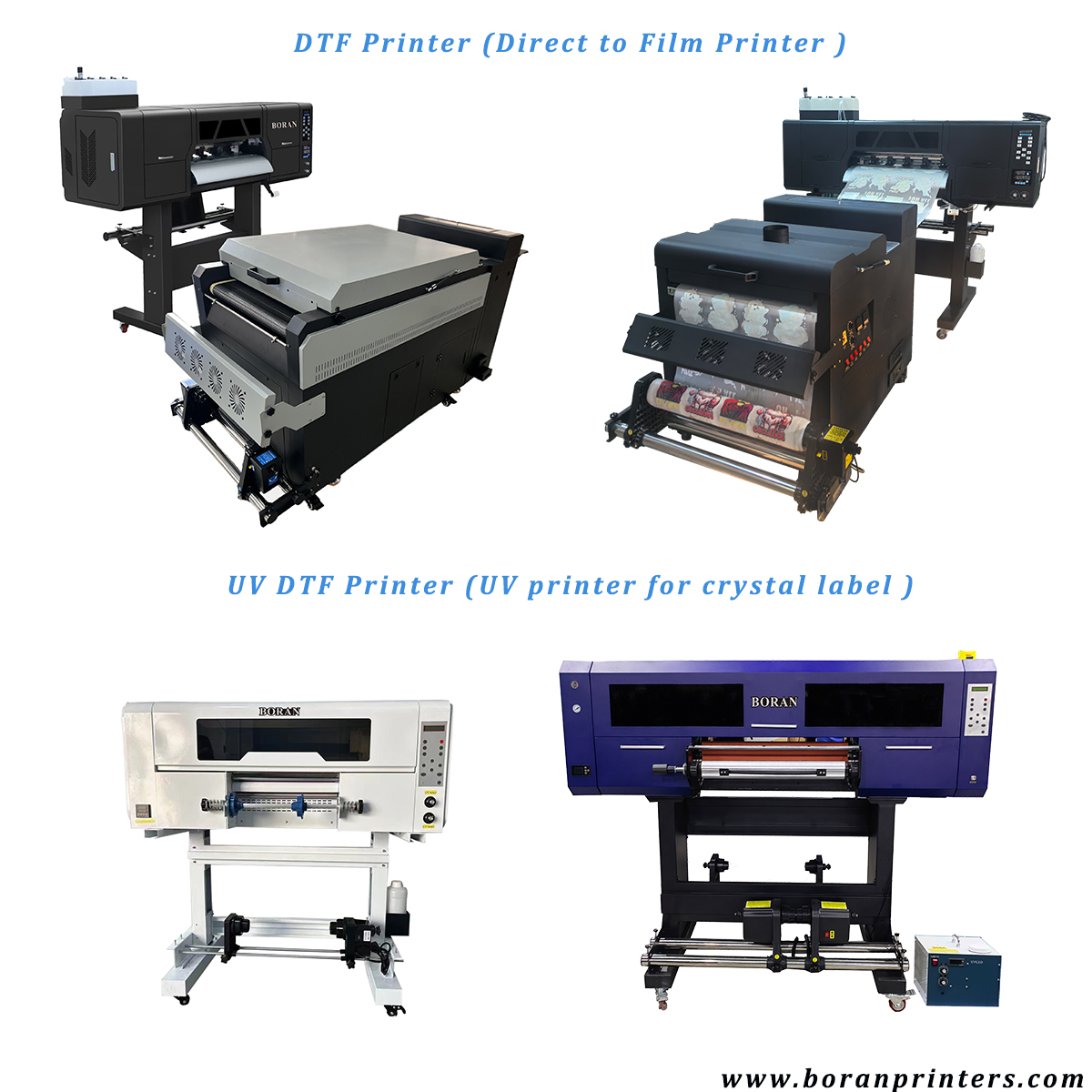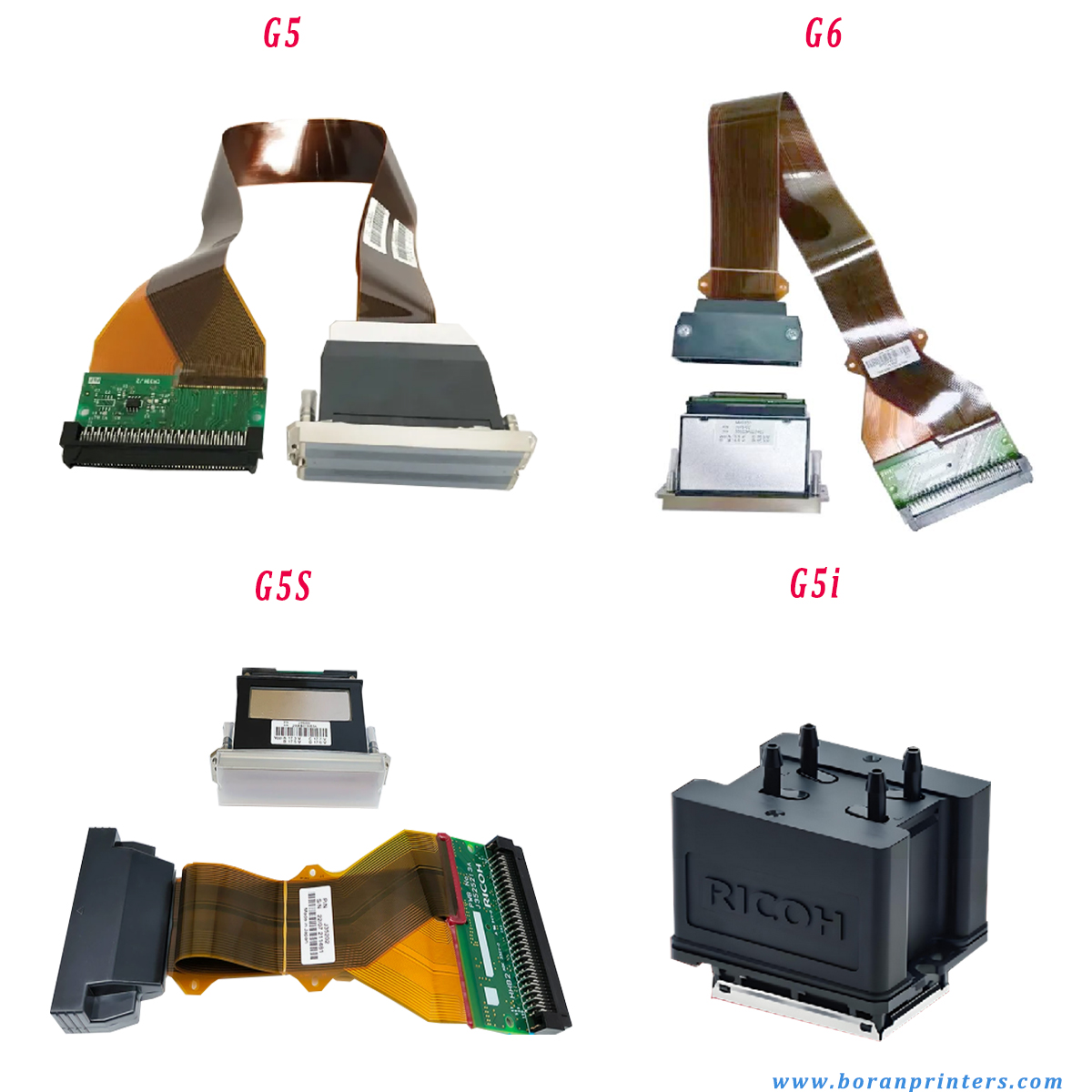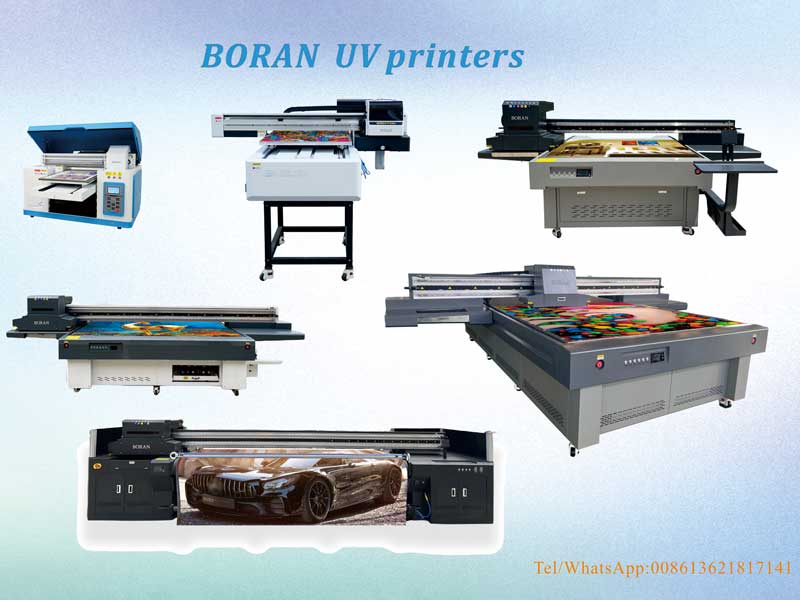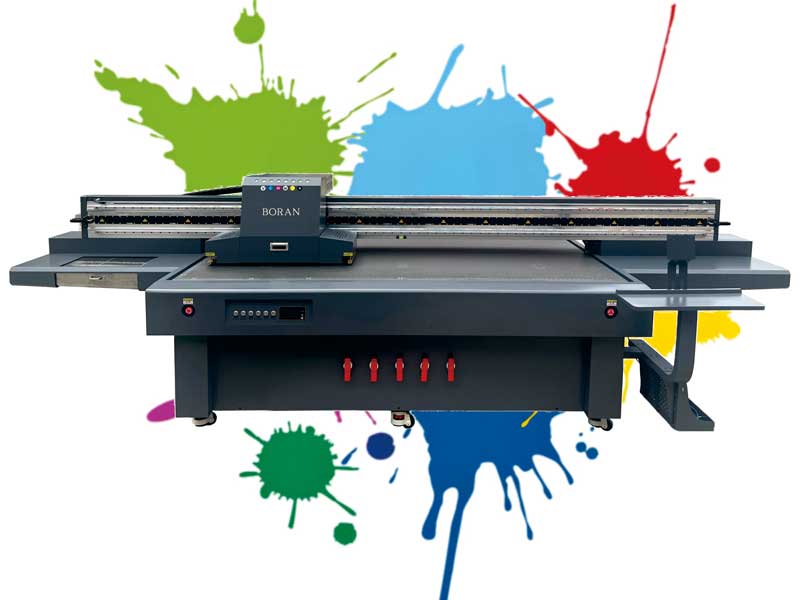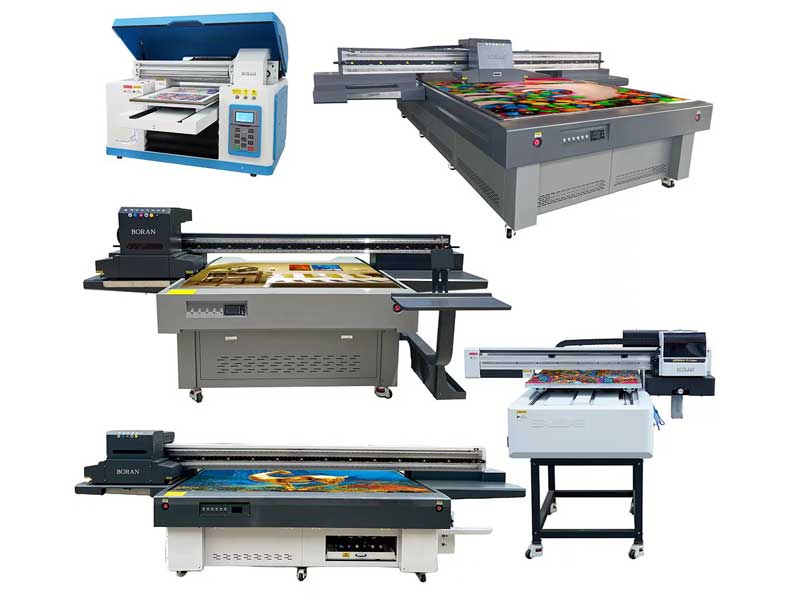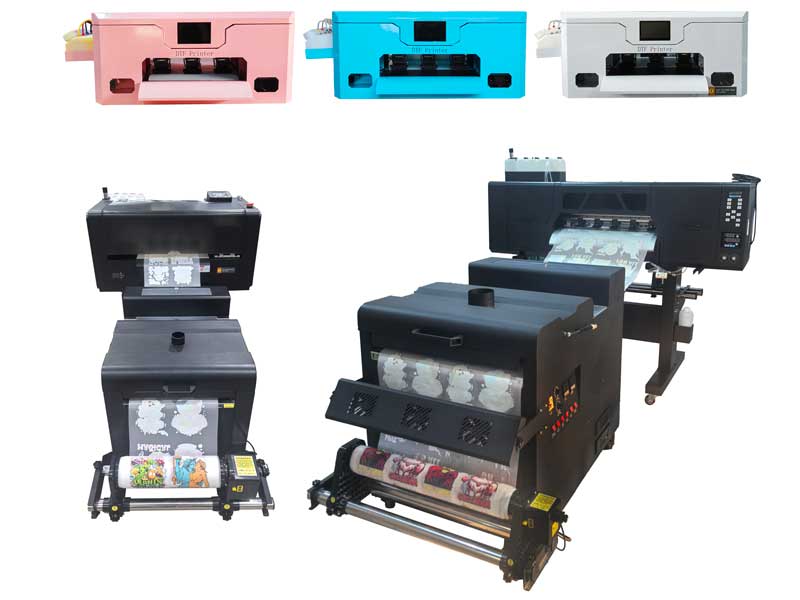What’s the difference between DTF Printing and Sublimation Printing?
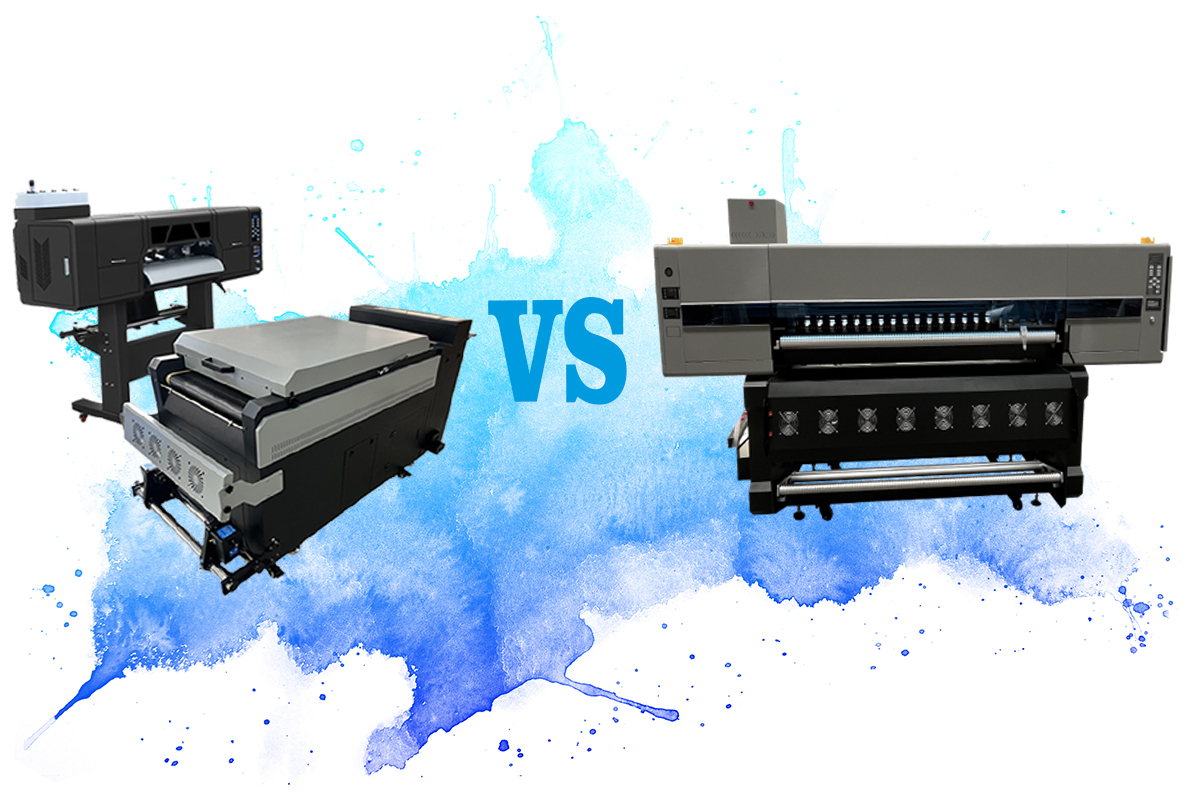
Dtf (Direct to Film) printing and Sublimation printing are two prominent methods in the textile and promotional product customization industry, each offering distinct advantages and limitations. While both involve transferring designs using heat, their underlying principles, material compatibility, aesthetic outcomes, and overall application differ significantly. Understanding these distinctions is crucial for businesses and individuals to select the most appropriate printing technique for their specific needs.
1. Fundamental Principle: How They Work
DTF (Direct to Film) Printing
Dtf Printing is a multi-step process that utilizes a special PET film as an intermediate carrier for the design. The core idea is toprint the design onto a film, then transfer it to the fabric.
1.Ink Application on Film: A Dtf Printer uses specialized water-based pigment inks (typically CMYK plus white ink) to print the desired design directly onto a treated PET transfer film. Crucially, the white ink is printed as a base layer on top of the colored inks. This white layer acts as an opaque background, ensuring that the colors of the design remain vibrant and true, especially when transferred onto dark-colored garments.
2.Adhesive Powder Application: Immediately after the ink is printed and while it's still wet, a hot-melt adhesive powder (usually a fine white granular substance) is evenly sprinkled over the wet ink. The powder adheres only to the inked areas.
3.Curing/Melting: The film with the ink and adhesive powder is then cured, often in a specialized oven or with a curing unit. This heating process melts the adhesive powder, causing it to fuse with the ink layer, forming a durable, transferrable film.
4.Heat Press Transfer: The cured film is placed onto the target fabric, and a heat press is used to apply high temperature and pressure. The heat reactivates the adhesive, causing the design layer to bond securely with the fabric fibers.
5.Peeling: Once cooled (or sometimes while warm, depending on the film type), the PET film is peeled away, leaving the design permanently affixed to the garment's surface.
Sublimation Printing
Sublimation printing, by contrast, relies on a unique chemical process where specialized dyes transition directly from a solid state to a gaseous state (sublimation) when subjected to heat, bypassing the liquid phase. The essence of sublimation is infusing the dye directly into the material's fibers.
1.Ink Application on Transfer Paper: A sublimation printer uses dedicated sublimation inks (CMYK dyes, typically no white ink) to print the design onto a special sublimation transfer paper. This paper is coated to hold the ink precisely and release it efficiently during the heating process.
2.Heat and Pressure Application: The printed transfer paper is placed onto the target material, and a heat press applies intense heat (typically between 180-220°C or 350-400°F) and pressure for a specific duration (usually 30-60 seconds).
3.Dye Sublimation and Infusion: Under this heat and pressure, the sublimation inks transform into a gas. Simultaneously, the pores of the polyester fibers in the target material open up. The gaseous dye molecules then penetrate these open pores and bond permanently with the polyester molecules.
4.Cooling and Solidification: As the material cools, the polyester fibers' pores close, trapping the now solid dye particles within the fabric structure.
5.Paper Removal: The transfer paper is removed, revealing the vibrant, fully integrated design.
2. Material and Color Compatibility: What Can Be Printed On
DTF Printing
DTF boasts exceptional versatility in terms of material compatibility. Because the design is effectively a layer adhered to the surface of the fabric, it can be applied to a vast array of textiles, including:
Natural Fibers: Cotton, linen, silk, rayon.
Synthetic Fibers: Polyester, nylon, spandex, lycra.
Blends: Cotton-polyester blends, tri-blends.
Other Materials: Denim, leather, canvas, non-woven fabrics, Oxford cloth.
Crucially, DTF printing supports the use of white ink. This means it can effectively print vibrant, opaque designs on any color fabric, including dark and black garments, without the underlying fabric color influencing the final design's appearance.
Sublimation Printing
Sublimation printing has significant limitations regarding material compatibility. It is primarily suited for:
●High-Polyester Fabrics: For textiles, the material must be made of at least 23% polyester, with higher polyester content (e.g., 65% or 100%) yielding the best and most vibrant results. The sublimation dyes bond directly with polyester molecules; natural fibers like cotton do not react with these dyes, resulting in faded or non-existent prints.
●Polymer-Coated Hard Substrates: Beyond textiles, sublimation is widely used for hard-surface items that have a special polymer coating. Examples include ceramic mugs, metal plaques, phone cases, mousepads, keychains, and glassware. This coating acts as a receptive layer for the sublimation dyes.
Regarding color, sublimation printing cannot print white. Any white areas in a design will appear as the base color of the material. Consequently, it is almost exclusively used on white or very light-colored materials. Printing on dark materials with sublimation is ineffective as the semi-transparent dyes will be absorbed by the dark background, rendering the design invisible or severely distorted.
3. Print Feel and Aesthetic: The Look and Touch
DTF Printing
Aesthetic: DTF prints are known for their sharp, crisp details and vibrant, opaque colors. They can reproduce intricate designs, fine lines, and photorealistic images with high fidelity. The colors stand out boldly on the fabric surface.
Hand Feel: Since the design forms a distinct layer on top of the fabric, DTF prints have a noticeable "hand feel" or texture. This can range from a soft, thin layer to a slightly thicker, plasticky feel, depending on the amount of ink and adhesive used and the overall design coverage. Large solid areas tend to feel heavier and less breathable than the fabric itself.
Sublimation Printing
Aesthetic: Sublimation prints offer incredibly smooth, vibrant, and seamlessly integrated designs. The colors are brilliant and deeply saturated, often appearing to glow. Since the dye becomes part of the fabric, there are no harsh edges or textures; the design transitions fluidly. It's excellent for full-bleed designs and gradients.
Hand Feel: This is a major advantage of sublimation. Because the dye is infused into the fibers rather than sitting on top, the print has virtually no hand feel. The fabric retains its original softness, breathability, and drape, making it ideal for performance wear and comfortable apparel.
4. Durability and Washability: Longevity of the Print
DTF Printing
DTF prints offer good durability and washability. They are generally resistant to cracking, peeling, and fading when cared for properly (e.g., washing inside out with cold water, avoiding harsh detergents and high heat drying). The longevity can vary based on the quality of the ink, film, adhesive, and the application process. While robust, prolonged heavy abrasion or repeated stretching might eventually show signs of wear.
Sublimation Printing
Sublimation prints are renowned for their exceptional and often permanent durability. Since the dye is permanently bonded within the polyester fibers, the prints are highly resistant to fading, cracking, peeling, or washing out, even after numerous wash cycles. They are generally as durable as the garment itself. This makes sublimation ideal for items that undergo frequent washing or heavy use, such as sportswear.
5. Cost and Efficiency: Economic Considerations
DTF Printing
Initial Cost: The upfront investment for DTF printers, films, and adhesive powders is generally lower than for comparable sublimation setups, making it more accessible for small businesses, startups, and hobbyists.
Production Efficiency: DTF is very efficient for small to medium-sized runs and on-demand custom orders. The process is relatively straightforward, requires minimal pre-treatment of garments, and offers a quick turnaround time, allowing for agile production.
Sublimation Printing
Initial Cost: Sublimation printers, specialized inks, and high-quality transfer papers can represent a higher initial investment. Additionally, the cost of specialized polyester or poly-coated blanks can add up, especially for hard substrates.
Production Efficiency: Sublimation is often more cost-effective for medium to large-scale production runs due to its speed and consistent output once the setup is complete. However, for very small batches or frequent design changes, the setup time might make it less efficient than DTF.
6. Environmental Aspects: A Sustainable Perspective
DTF Printing
DTF printing typically uses water-based pigment inks, which are generally more environmentally friendly than solvent-based alternatives due to lower VOC (Volatile Organic Compound) emissions. However, the use of hot-melt adhesive powders and the disposal of used PET films are considerations. While efforts are being made to develop more eco-friendly options, the overall environmental impact depends on specific materials and waste management practices.
Sublimation Printing
Sublimation is often considered a relatively environmentally friendly printing method. The dye-to-gas process minimizes liquid waste, and the dyes are typically water-based. There are no screens or harsh chemicals to clean up, reducing chemical runoff. However, the reliance on polyester (a synthetic fiber) and the disposal of used transfer papers are factors to consider in a broader environmental context.
Conclusion
In summary, the choice between DTF and sublimation printing hinges on several critical factors:
Material: If you primarily print on natural fibers (like cotton) or dark-colored garments, DTF is the clear winner due to its versatility and white ink capability. If your focus is on polyester-rich fabrics or poly-coated hard substrates, sublimation is the go-to.
Hand Feel: For a "no-feel" print that is breathable and integrated into the fabric, sublimation excels. If a slightly tactile print is acceptable or desired for vibrant opacity, DTF is suitable.
Durability: Both offer good durability, but sublimation boasts superior, virtually permanent resistance to fading and washing.
Aesthetics: DTF provides sharp, opaque, vibrant prints that sit on the surface. Sublimation offers seamless, incredibly vibrant, and deeply infused colors with no texture.
Cost & Volume: DTF is often more accessible for lower initial investment and suitable for small, on-demand custom orders. Sublimation may have higher initial costs but can be more cost-effective for larger volumes on compatible materials.
By weighing these distinctions, businesses and creatives can make informed decisions to leverage the strengths of each printing technology for their specific applications, ensuring optimal results and customer satisfaction.
More details, contact us:www.boranprinter.com.

